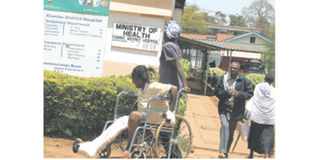No help from Mama Lucy hospital

Photo/WILLIAM OERI
Ms Margaret Njambi is wheeled away from Kiambu District Hospital on Saturday. Patients had to seek attention elsewhere as staff here and at other public health facilities around the country continued their strike.
Nairobi’s second referral hospital remained open but severely incapacitated by the nationwide strike staged by health workers that has piled pressure on Kenyatta National Hospital.
Mama Lucy Kibaki Hospital in Embakasi, which was expected to ease pressure on Kenyatta, turned away patients on Saturday after staff failed to turn up in defiance of a ministerial directive.
As the strike entered its ninth day, Medical Services minister Anyang’ Nyong’o said the government had honoured its part of the deal that was struck with health professionals last December.
“I hereby clarify that contrary to what has been appearing in the press with regard to payment of extraneous allowances to health personnel, the government has fully honoured the agreement reached by the Kenya Health Professional Society on December 1, 2011,” Prof Nyong’o says in an advertisement published elsewhere in this paper.
Phase two of the payments for extraneous allowances will kick in in July, Prof Nyong’o says, adding that other outstanding matters would be handled as soon as funding and approvals from the Treasury are granted.
A spot check at Mama Lucy Kibaki Hospital, which is one of Kenya’s newest and most modern hospitals, established that the wards were locked and the consultation rooms were empty save for a few hopeful patients at the reception.
The only staff present were security personnel, administrators and casual workers. “We are not operational since the strike started last week,” one of the striking nurses in civilian clothes told the Sunday Nation outside the hospital grounds.
The nurses congregated outside the hospital grounds and conversed in low tones on their fate following a government announcement that they had been sacked.
The nurses, dressed in civilian clothes, said they had inconspicuously reported at the hospital to assess the atmosphere.
The 112-bed capacity referral hospital located in Nairobi’s Umoja-Komarock area was projected to serve at least two million people in Eastlands area but, with the current strike, patients in the area and its environs are forced to seek medical attention from private facilities or at Kenyatta National Hospital.
The Chinese Government funded construction of the hospital at a cost of Sh544 million. About Sh417 million was used for civil works while Sh117 million went towards purchase of medical equipment.
The change of name from Embakasi District Hospital to Mama Lucy Kibaki Hospital Embakasi was published in a Gazette notice dated June 20, last year.
The ministry of Medical Services had said this followed a request by the Embakasi District Development Committee to honour the First Lady.
On Thursday last week, the government announced the sacking of 25,000 striking workers and invited qualified but unemployed Kenyans and retired officers to apply for the positions starting the next day.
Announcing the sack, government spokesman Alfred Mutua had said it was unethical for health professionals to abscond from duty.
“It is wrong regardless of any disagreement for a health professional to abscond from duty and lead to loss of life or suffering. The government and indeed the people of Kenya will not tolerate this,” Dr Mutua said.
Experiencing strain
Health workers at Kenyatta National Hospital were not on strike but the hospital is handling an influx of patients from other health facilities like Mbagathi and other government-run health facilities.
KNH chief executive Richard Lesiyampe told the Sunday Nation that the country’s largest referral hospital was experiencing a strain.
“Among the patients we received are eight babies from Machakos District Hospital, some are pre-term, prompting us to increase the incubators in the nursery,” Mr Lesiyampe said.
“We are only admitting the critical cases while the rest are being treated as outpatients to avoid congestion.”
Operations at Kiambu District Hospital were also paralysed as patients were transferred to other health facilities, or taken home.
Only seven patients remain at the health facility at the Nyayo surgical wards at the hospital. Mbagathi hospital only had seven patients but did not offer any services.
The situation was the same in Nandi, Kapsabet, Webuye, Bungoma and Iten district hospitals with a few patients waiting and hoping to be attended to.
At Moi Teaching and Referral Hospital and Uasin Gishu District Hospital in Eldoret, health workers ignored the call to down tools and reported to work as usual.
A spot-check at the referral facility indicated that nurses and other health workers were busy attending to patients in various sections.
A huge number of patients were seen at the outpatient wing of the two medical institutions, and patients commended the health personnel for living up to their oath that prioritises human life.
However, some of the nurses appealed to the Medical Services minister to desist from issuing threatening directives, saying such utterances were likely to strengthen their resolve to strike.
“He should stop intimidating us that he can sack the more than 25,000 health workers and replace them with equally competent personnel,” said a nurse at the MTRH who declined to be named for fear of retribution.
Reported by Joy Wanja, Ouma Wanzala, Dennis Odunga, Tom Matoke and Erick Ngobilo




